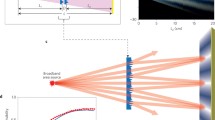Abstract
The phenomenon of the repetitive patterns observed beyond the plane of grating, when using monochromatic collimated light, is discussed. A more complete derivation and discussion of the equation giving the distance from the grating, where the reproduction of the grating will be located, than those introduced previously in the literature is given. The derived equations and the presented discussion are important in the process of moiré-pattern observation and in the process of copying masters. Experimental data concerning the location of the gratings and tolerances of this location for a given value of the contrast in the formation of moiré patterns, or in copying gratings, are given.
Similar content being viewed by others
Abbreviations
- a :
-
constant<1
- A (x,z) :
-
amplitude of the light-wave fronts
- A o , B o , C o :
-
coefficient of the Fourier expansion of the grating transmission function
- C :
-
film contrast
- C rel :
-
relative film contrast
- D :
-
film density
- E :
-
film exposure equalI·t
- I :
-
light-intensity amplitude
- Ti (ϕ):
-
Bessel's integrals of the argument ϕ,i=0, 1, 2
- k :
-
integer 1, 2, 3…
- m :
-
integer 1, 2, 3…
- n :
-
integer 1, 2, 3…
- p :
-
grid pitch
- T :
-
film transmissibility
- t :
-
time
- x :
-
coordinate contained in the plane of the grating
- y :
-
coordinate contained in the plane of the grating
- z :
-
coordinate perpendicular to the plane of the grating
- z no :
-
cycle value corresponding to thenth-order diffraction wave front
- z 0 :
-
cycle value corresponding to the first-order diffraction wave front
- α:
-
angular radius of the light source as seen from the entrance pupil of the collimating lens
- β:
-
angle between the grating and the photographic plate
- δ:
-
phase angle corresponding to the cycle valuez 0
- θ n :
-
diffraction angle of thenth-order diffraction wave front
- λ:
-
wavelength of light
- Δϕn :
-
phase error corresponding toz n0 computed by the first-order approximation
- Δϕ0n :
-
total phase error corresponding toz 0
- Δζ:
-
path difference corresponding to the phase difference ΔΦ
- ΔΦ:
-
phase difference between the first order wave and the zero order wave due to the film corrugation
- ϕ:
-
peak to peak phase variation of the corrugation function
References
Sciammarella, C. A., and Chiang, Fu-pen, “Gap Effect on Morié Fringes,” presented to the Canadian Centennial Congress of Applied Mechanics, Quebec, Canada (1967).
McIlraith, A. H., “An Introduction to the Theory of Crossed Diffraction Gratings and Their Application to Linear Measurement,” Machine Shop Magazine,23 (4) (April 1962).
Burch, J. M., “Metrological Applications of Diffraction Gratings,” Progress in Optics, Vol. II.
Sciammarella, C. A., “Basic Optical Law in the Interpretation of Moiré Patterns Applied to the Analysis of Strains, Part 1,”Experimental Mechanics,5 (5),154–160 (May1965).
Francon, M., “Optical Interferometry,” Academic Press, 27 (1966).
Born and Wolf, “Principles of Optics,” MacMillan (1964).
Author information
Authors and Affiliations
Rights and permissions
About this article
Cite this article
Sciammarella, C.A., Davis, D. Gap effect in moiré fringes observed with coherent monochromatic collimated light. Experimental Mechanics 8, 459–466 (1968). https://doi.org/10.1007/BF02327410
Issue Date:
DOI: https://doi.org/10.1007/BF02327410




